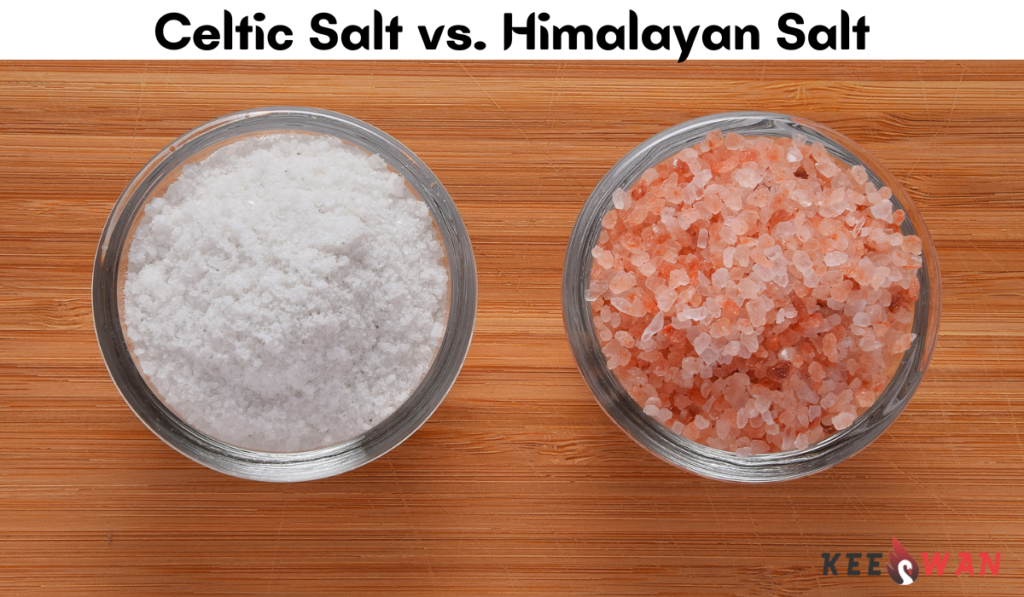Introduction
Embark on a culinary exploration as we dive into the fascinating world of Celtic Salt and Himalayan Salt. At Keeswan, we unravel the nuances of these two mineral-rich salts, exploring their origins, unique compositions, and the distinctive flavors they bring to your table. In this article, we’ll guide you through the characteristics of Celtic Salt and Himalayan Salt to help you make an informed choice for your culinary endeavors.
Celtic Salt: Essence of the Sea
Origin and Harvesting
Celtic Salt, also known as grey salt or sel gris, traces its origins to the coastal regions of France. Harvested through an age-old method, this salt is sun-dried and hand-raked, retaining the minerals and moisture from the pristine waters of the Atlantic. The distinctive grey hue is a testament to its mineral content.
Mineral-Rich Complexity
What sets Celtic Salt apart is its complex mineral composition. Beyond sodium chloride, it contains trace minerals like magnesium, potassium, and calcium. These minerals contribute to a nuanced flavor profile, making Celtic Salt a favorite among chefs seeking to enhance the taste and texture of their dishes.
Himalayan Salt: Pink Perfection
Geological Origins
Himalayan Salt, hailed for its distinctive pink hue, is extracted from the ancient salt mines of the Himalayan Mountains. Formed millions of years ago, this salt is a crystallized treasure, rich in minerals like iron, potassium, and magnesium. The unique coloration is attributed to the presence of these minerals.
Wellness and Purity
Apart from its culinary uses, Himalayan Salt is celebrated for its holistic wellness properties. Some claim that it can help balance the body’s pH, improve hydration, and support respiratory health. While these claims are not universally accepted, the purity of Himalayan Salt has made it a sought-after choice for health-conscious consumers.
Flavor Profiles: Celtic vs. Himalayan
Celtic Salt’s Bold Salinity
Celtic Salt boasts a robust and briny flavor, adding depth to dishes with its pronounced saltiness. The mineral complexity lends a subtle earthiness, making it an ideal choice for seasoning meats, enhancing the flavor of roasted vegetables, and finishing gourmet dishes.
Himalayan Salt’s Subtle Elegance
In contrast, Himalayan Salt offers a milder and more delicate flavor. The pink crystals dissolve smoothly, imparting a gentle salinity to your dishes. Its versatility makes it suitable for a variety of cuisines, from seasoning grilled fish to delicately enhancing the sweetness of chocolate desserts.
Making the Right Choice
Culinary Application
When choosing between Celtic Salt and Himalayan Salt, consider the culinary application. Celtic Salt’s bold flavor makes it suitable for hearty dishes and robust flavors, while Himalayan Salt’s subtlety shines in dishes where a lighter touch is desired.
Mineral Preferences
If you prioritize a diverse mineral profile in your salt, Celtic Salt might be your preference due to its higher mineral content. However, if you are drawn to the unique pink hue and potential wellness properties, Himalayan Salt could be the ideal choice.
Conclusion: Elevating Your Culinary Experience
In conclusion, the choice between Celtic Salt and Himalayan Salt is a matter of personal preference and culinary intent. Both salts bring their own distinct characteristics to the table, elevating your dishes with flavors that captivate the palate.





